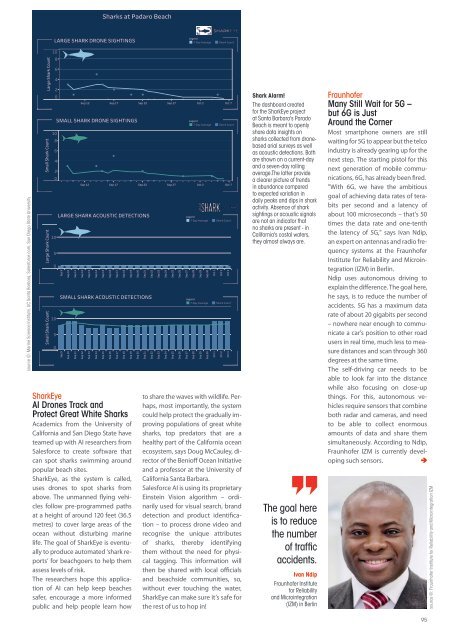Smart Industry No.1 2022
Smart Industry No.1 2022 - The IoT Business Magazine - powered by Avnet Silica
Smart Industry No.1 2022 - The IoT Business Magazine - powered by Avnet Silica
You also want an ePaper? Increase the reach of your titles
YUMPU automatically turns print PDFs into web optimized ePapers that Google loves.
source ©: Marine Science Institute, UC Santa Barbara, Salesforce.com, San Diego State University<br />
SharkEye<br />
AI Drones Track and<br />
Protect Great White Sharks<br />
Academics from the University of<br />
California and San Diego State have<br />
teamed up with AI researchers from<br />
Salesforce to create software that<br />
can spot sharks swimming around<br />
popular beach sites.<br />
SharkEye, as the system is called,<br />
uses drones to spot sharks from<br />
above. The unmanned flying vehicles<br />
follow pre-programmed paths<br />
at a height of around 120 feet (36.5<br />
metres) to cover large areas of the<br />
ocean without disturbing marine<br />
life. The goal of SharkEye is eventually<br />
to produce automated ‘shark reports’<br />
for beachgoers to help them<br />
assess levels of risk.<br />
The researchers hope this application<br />
of AI can help keep beaches<br />
safer, encourage a more informed<br />
public and help people learn how<br />
to share the waves with wildlife. Perhaps,<br />
most importantly, the system<br />
could help protect the gradually improving<br />
populations of great white<br />
sharks, top predators that are a<br />
healthy part of the California ocean<br />
ecosystem, says Doug McCauley, director<br />
of the Benioff Ocean Initiative<br />
and a professor at the University of<br />
California Santa Barbara.<br />
Salesforce AI is using its proprietary<br />
Einstein Vision algorithm – ordinarily<br />
used for visual search, brand<br />
detection and product identification<br />
– to process drone video and<br />
recognise the unique attributes<br />
of sharks, thereby identifying<br />
them without the need for physical<br />
tagging. This information will<br />
then be shared with local officials<br />
and beachside communities, so,<br />
without ever touching the water,<br />
SharkEye can make sure it’s safe for<br />
the rest of us to hop in!<br />
Shark Alarm!<br />
The dashboard created<br />
for the SharkEye project<br />
at Santa Barbara's Parado<br />
Beach is meant to openly<br />
share data insights on<br />
sharks collected from dronebased<br />
arial surveys as well<br />
as acoustic detections. Both<br />
are shown on a current-day<br />
and a seven-day rolling<br />
average.The latter provide<br />
a clearer picture of trends<br />
in abundance compared<br />
to expected variation in<br />
daily peaks and dips in shark<br />
activity. Absence of shark<br />
sightings or acoustic signals<br />
are not an indicator that<br />
no sharks are present - in<br />
California's costal waters,<br />
they almost always are.<br />
The goal here<br />
is to reduce<br />
the number<br />
of traffic<br />
accidents.<br />
Ivan Ndip<br />
Fraunhofer Institute<br />
for Reliability<br />
and Microintegration<br />
(IZM) in Berlin<br />
Fraunhofer<br />
Many Still Wait for 5G –<br />
but 6G is Just<br />
Around the Corner<br />
Most smartphone owners are still<br />
waiting for 5G to appear but the telco<br />
industry is already gearing up for the<br />
next step. The starting pistol for this<br />
next generation of mobile communications,<br />
6G, has already been fired.<br />
"With 6G, we have the ambitious<br />
goal of achieving data rates of terabits<br />
per second and a latency of<br />
about 100 microseconds – that’s 50<br />
times the data rate and one-tenth<br />
the latency of 5G," says Ivan Ndip,<br />
an expert on antennas and radio frequency<br />
systems at the Fraunhofer<br />
Institute for Reliability and Microintegration<br />
(IZM) in Berlin.<br />
Ndip uses autonomous driving to<br />
explain the difference. The goal here,<br />
he says, is to reduce the number of<br />
accidents. 5G has a maximum data<br />
rate of about 20 gigabits per second<br />
– nowhere near enough to communicate<br />
a car’s position to other road<br />
users in real time, much less to measure<br />
distances and scan through 360<br />
degrees at the same time.<br />
The self-driving car needs to be<br />
able to look far into the distance<br />
while also focusing on close-up<br />
things. For this, autonomous vehicles<br />
require sensors that combine<br />
both radar and cameras, and need<br />
to be able to collect enormous<br />
amounts of data and share them<br />
simultaneously. According to Ndip,<br />
Fraunhofer IZM is currently developing<br />
such sensors.<br />
source ©: Fraunhofer Institute for Reliability and Microintegration IZM<br />
95
















